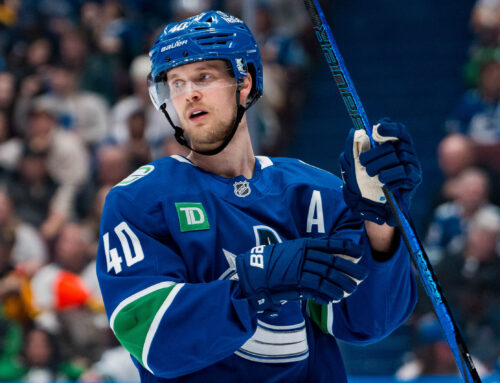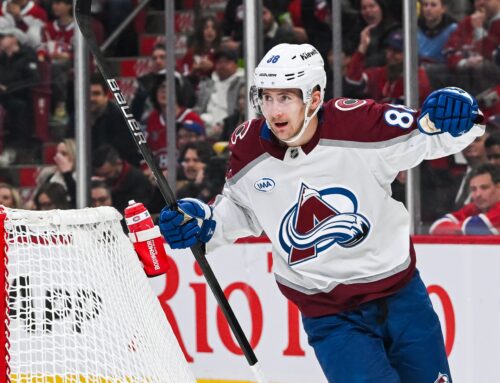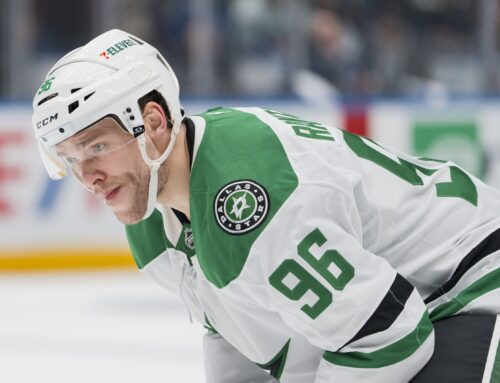
The offseason fantasy hockey outlooks for the Edmonton Oilers and Vancouver Canucks…
It is time to start looking forward to next season. Over the next seven weeks each of the 14 Western Conference teams will be featured two at a time in reverse order of their finish this past season. This week will feature two teams going in opposite directions; the Vancouver Canucks and the Edmonton Oilers.
Edmonton
Edmonton has been making small steps in the right direction over the last two years but the results have not been showing up in their finish in the overall standings. On offense while they only took a step forward in producing goals they took almost a full shot more per 60 minutes than they did last year and two more shots per game than the year before. Even more importantly by looking at the jump in their expected goals per 60 minutes it is apparent that the not only did they take more shots but that more of the shots they were taking were better scoring chances. The fact that they did not see a corresponding jump in their goal production is no doubt linked to their low shooting percentage, which should have been higher based on them taking better shots. On defense they are also moving in the right direction as they their shots against per 60 minutes in the neighbourhood of 30 shots while increasing their team save percentage to an almost respectable 90.5%. That does not take into account the horrible start to the season their goalies had in which the team struggled until December to post a save percentage of even 90%.
The Oilers lost Connor McDavid for almost half the season and still managed to better their production rate from the previous season. They also managed to increase their shot rate and more of the same should expected as McDavid drives the Oilers into elite shot rates at even strength, nearly cracking 34 shots per 60 minutes. More importantly though the Oilers expected and goal rate are also significantly higher when he is on the ice. Their expected goal rate goes by 0.7 per 60 minutes while their goal goes up by a full goal per 60 minutes while at even strength. To put into context the Oilers expected goal rate with McDavid on the highest is the highest in the league and their actual goal is in the top 10, just below Jaromir Jagr, Joe Thornton and Evgeny Kuznetsov. The difference between those three and McDavid is that his was the only PDO that was lower than expected, although much of that is due to save percentage. The key will be identifying who McDavid’s linemates are next season. Based on the end of this season the expectation should be that he will play primarily with Jordan Eberle and Benoit Pouliot, both of whom experienced enormous production bumps when McDavid was in the lineup. The fact that each player played fewer than half their minutes at even strength with McDavid despite getting more than half their points with him on the ice could drag down their value with inattentive poolies. Given that Yakupov experienced the same production bump when with McDavid it is safe to say that the McDavid bump is real.
If the McDavid line is set than the Hall should be almost safe as Leon Draisaitl, Taylor Hall and Teddy Purcell were one of the best lines in hockey for a couple of months. While much of that success was driven by Draisaitl’s shooting percentage eclipsing 20%, they also drove play to a large extent, nearing the effect that McDavid has when he is on the ice. While neither line is especially good at suppressing shots against both cleared 33 shots per 60 minutes at even strength. Over 33 shots per 60 minutes is largely good enough to be ranked 50 in the league meaning that the Oilers already have the makings of the two of the best lines in the league. As such it is reasonable to assume that given their shot rates the Hall line would have found success even if Draisaitl had not started scoring on every fourth shot. This past season there was a similar if less drastic effect to playing with Hall as there was from playing with McDavid, namely more shots, more goals and more points. There is the potential for there to basically be two number one lines here, as both the McDavid and Hall lines showed the ability to score in that manner at various times throughout the season.
The questions with the Oilers come on the back end and how the Oilers plan to address those issues. Andrej Sekera and Mark Fayne are both capable NHL defenders but neither should be on a top pairing. While Fayne has little fantasy value Sekera is capable of producing especially when given power play time as he was this year. Sekera will get hit the hardest should the Oilers go out and acquire a true top pairing offensive defenseman. As the Oilers generally ran power play units with four forwards on them a better option could see Sekera’s power-play time cut drastically. It would be cut even more so as Darnell Nurse and Oscar Klefbom develop. Jeff Marek has reported recently that the Oilers and Ducks were very close to a deal this season. One would assume that any such deal would see one of Cam Fowler, Hampus Lindholm or Sami Vatanen come to Edmonton, each of whom would be expected to supplant Sekera on the top power play. Furthermore, with the Oilers dropping to fourth the door is open more so than ever before for them to take a defenseman with their first round pick. In short Sekera could see himself rapidly push down the depth chart in short order. This would be a negative for Sekera put generally a positive for the Oilers and their goalies as it would mean a deep and rapidly improving defense corps. Should the Oilers trade for a top pairing defenseman it would likely mean the exit of one or both of Ryan Nugent-Hopkins and Nail Yakupov. For both players it would likely be for the best as Yakupov has fallen out favor and there is the serious potential for RNH to play Jordan Staal to McDavid’s Crosby and Hall’s Malkin.
In goal there is reason for optimism, and not just because it appears that the Oilers will be addressing their defense issues this summer. While Cam Talbot struggled at the beginning of the season he made huge strides during the second half. From January on until a blip at the end of the season Talbot was an above average goalie, even playing well enough that for much of the second his save percentage was above 92%. Given the volume and quality of the shots that Talbot faced it is even more impressive that he was able to post such numbers at any point in the season. Should the Oilers address their issues on the back end Talbot should begin stand out more as a quality fantasy option.
Vancouver
While there is reason for optimism in Edmonton there it is the beginning of some dark days in Vancouver. Whereas two years ago the Canucks used to out shoot their opponents by 2.5 shots per game this year they were on average out shot by 4.5 shots per game. Lest anyone think this a one-year blip, they have allowed an extra shot per game in each of the last two years. Thus even if their plummeting shot rate this year is a blip it would at best have them on par with their opponents. The single season blip theory is highly as it would necessitate that every Canuck experienced a simultaneous drop in their shot rate as the only individual to be on the ice for more than 30 shots per 60 minute was Radim Vrbata. Even the Sedins who are routinely between 31 and 33 shots per 60 minutes fell under 29 shots per 60 minutes. There is not a whole lot to like about this team from a fantasy perspective.
The Sedins are symbolic of the overall trend in Vancouver. The Canucks get fewer shots than ever before when the Sedins are on the ice as they allow more than ever before. That is not a reflection of the play of the Sedins, as it is difficult to generate shots offensively or suppress shots defensively with as lackluster a defense corps as have the Canucks. There are not the puck movers to get the puck up to the Sedins, which is as important as ever because while the Sedins can still dominate in the offensive zone they have lost a step through the neutral zone. Without puck moving defensemen to get them the puck they are now required to do more of the heavy lifting in transition. This has stripped the Sedins of some of their value but they were that both would have had 60 points over a full season. A better measure of their relevance may be that they were able to make Jannik Hansen relevant in fantasy circles with 38 points in 67 games, a 45 point pace.
The problem for the Canucks is an overall lack of talent, as other than the Sedins only one player managed get to 40 points. That was Bo Horvat who looks like a serviceable fantasy hockey option in deeper pools despite starting 40% of the time in the defensive zone and often facing some of the toughest competition. While the Sedins benefit from that usage greatly by starting 60% of their shifts in the offensive zone there is no second scoring line on the Canucks. A great example of this is how Radim Vrbata fell off drastically once away from the Sedins as he failed to get even 30 points this season. It was not for a lack of trying either, as Vrbata still took more than two shots per game, although that fell off drastically over the season. As Vrbata is more of a sniper than a play driver he cannot carry a line, this makes him a great complementary piece for a center the Canucks do not have outside of the Sedins. Given that even Trevor Linden is calling this a transition period for the Canucks it would seem unlikely that Vrbata returns. Unless the Canucks get an offensive center capable of driving a second scoring line it is difficult to see where the fantasy value on this teams lies outside of the Sedins, their winger and Bo Horvat.
In short the Canucks have a plethora of complementary players with little to complement. Markus Granlund, Linden Vey, Emerson Etem, Jared McCann and Brandon Sutter are all decent, and could be part of something bigger, but none have shown the ability to drive a line on their own in the NHL. There does not seem to be much help in the pipeline either as the Canucks dropped to fifth in the draft and probably will be unable to get immediate help there. Jake Virtanen, their 2014 pick, puts some nice numbers for the analytics crowd but does not generate much actual offense. Someone needs to tell him that a 2-on-1 that results in a shot from just inside the blue line is a wasted odd man rush.
The Canucks are almost as barren on the backend as they are up front. Alex Edler remains a solid fantasy option as the only real option to quarterback the power play. With the Sedins still shining on the power play a spot on the Canucks’ top unit is still a boon to the overall counting stats. The only potential challenger to Alex Edler’s spot on the top unit is Ben Hutton. Hutton showed some promised this season and ended up with a much points per 60 minutes on the power play than Edler. He is however, very prone to mistakes as he led the team with 46 giveaways making him a risky proposition in any situation. The only other two name defensemen on the Canucks, Chris Tanev and Dan Hamhuis, are both more of the defensive variety and are not relevant in fantasy circles. Luca Sbisa and Matt Bartkowski make decent depth options for the peripheral categories in very deep leagues. Keep an eye on Nikita Tryamkin (profile here), the giant the Canucks brought in at year’s end. He averaged nearly three hits and two blocks per game. Over a full season that would place him in the top 20 in both categories, possibly top 10 in hits. With the Canucks in transition do not expect much help here, which leaves Edler and Hutton as the best options in traditional formats.
Where the Canucks are interesting is in net where Ryan Miller and Jacob Markstrom will share the crease for one more year. Both goalies posted league average numbers behind a porous defense with little offensive support. Barring injury Miller will get the bulk of the starts once again due to salary and name as their stats are nearly identical. Both are short-term solutions for the Canucks with Thatcher Demko (Demko profile here) having been signed this offseason. With Markstrom in the fold and playing at the same level as Miller this should be Miller’s last season as the Canucks’ starter. Given the state of the team bringing in another big name starter would seem nonsensical which makes Markstrom a good option as a second or third starter once Miller leaves.





 N.J
N.J NYR
NYR OTT
OTT FLA
FLA DAL
DAL PIT
PIT VAN
VAN ANA
ANA L.A
L.A EDM
EDM BUF
BUF T.B
T.B MTL
MTL PHI
PHI TOR
TOR CBJ
CBJ UTA
UTA WPG
WPG BOS
BOS CAR
CAR STL
STL COL
COL CGY
CGY VGK
VGK S.J
S.J SEA
SEA WSH
WSH CHI
CHI
